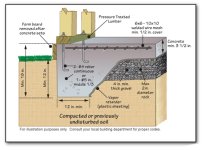Utopia Texas
Platinum Member
- Joined
- Aug 11, 2013
- Messages
- 755
- Location
- Brookshire & Cat Spring,Texas
- Tractor
- Kubota B2650 / Kubota L6060 / Kubota ZD2300
I am putting the figures together to install a 27KW generator for our house. We live on water and though the creek has never fLowed over the bank I would like to have the top of the slab\pad 1 foot above ground level. Can I fill the center of the form with crushed cinder blocks to fill in before pouring the concrete or should the whole pad be 1 foot deep? The unit will weight in at 960 pounds. Am I being too cheap filling space with crushed material?
